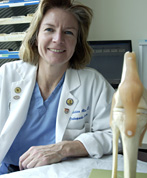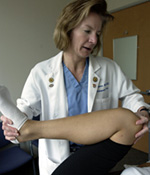
Christina Allen
An avid soccer player herself, orthopedic surgeon UCSF's Christina Allen, MD, specializes in the treatment of knee and shoulder injuries in athletes of all abilities.
Allen is part of the UCSF Sports Medicine team of experts - which includes orthopedic surgeons, family medicine specialists, physical therapists and fitness experts - who develop a treatment plan tailored to each patient's needs.
So when 23-year-old Mendocino college student Jeremy Decker went to his Ukiah-area doctor with a severely damaged knee after playing basketball, he was quickly referred to UCSF. There, Allen did a thorough physical examination, and looked at Decker's X-rays and knee MRI.
Decker explained that he was taking the ball to the basket when he felt a sharp pain and his right knee crumpled. As he tried to get up, he discovered that his knee continued to hurt and was locked in a bent position. Decker had twisted that knee four years previously, and over the years it occasionally became painful and swollen.
"At the time, the doctors said I couldn't hurt it anymore, and that it was just a question of how much pain I could tolerate," he says. So Decker played on the college basketball team, taking heavy doses of ibuprofen to control the swelling and discomfort.
But after the fateful layup, his knee hurt all the time. With one knee permanently bent, he could barely walk, much less play sports.
 |
Allen examines a patient. |
The knee is designed to carry large loads and yet remain flexible. It does this by creating bony pads where the femur (thighbone) and tibia (one of the bones in the lower leg) come together at the knee, and covering these bony pads with hyaline cartilage, a complex tissue that cushions the bones and allows them to slide smoothly against each other. The cartilage layer can be damaged, however, and once damaged it does not grow back or repair itself.
Allen saw that the cartilage in Decker's knee was damaged. In addition, the bone underneath was injured and dying in some places. She also saw the reason that his knee was locked so that he couldn't straighten it. A broken piece of bone and overlying cartilage had wedged itself in behind the kneecap and in front of his cruciate ligaments, basically acting as a block to straightening the knee.
Since torn hyaline cartilage cannot simply be sutured and repaired (as opposed to meniscus cartilage, which often can be repaired), Allen saw that this case would require more extensive reconstruction. Together, Allen and Decker decided on a course of action. Decker would need a transplanted piece of bone and cartilage from the knee of a donor or cadaver, much as people get heart or kidney transplants from donors.
After careful measurement of Decker's knee, Allen found a donor knee with the same measurements. She cut out a plug of Decker's damaged cartilage and bone, and then got a wedge of healthy bone and cartilage that exactly fit the hole in Decker's knee where the plug had been. The removal of the tissue that was locking up Decker's knee and the surgical implantation of the healthy graft were successful.
Decker finds that the knee after surgery is much improved. Although twisting motions like those involved in golf and snowboarding can still cause occasional discomfort, most athletic activities are "no problem," he says.
"It's great. I can play basketball all day long and it doesn't hurt," Decker says. "I can even dunk again."
Photos by Christine Jegan
Related Links:
Sports Medicine
UCSF Medical Center
UCSF Orthopedic Surgeon Volunteers Her Time to National Women's SoccerUCSF Today, September 25, 2006
Sports Medicine - Flying on a Fast TrackUCSF Today, March 22, 2004



